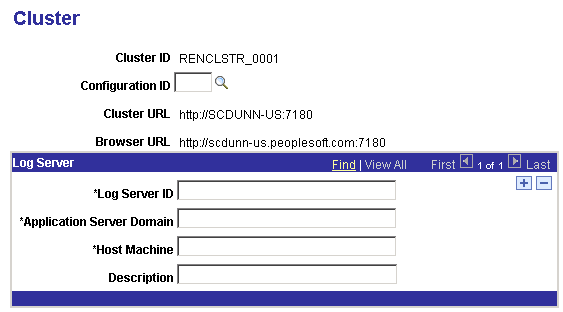Defining the PeopleSoft MCF Cluster Page for a Third Party
This section discusses how to define the PeopleSoft MCF Cluster page for the third party. To view the Cluster page, use the Cluster (MCF_TP_RENCFG_CMP) component.
The Cluster page displays the associated PeopleSoft MCF cluster URLs and log server details for the selected cluster.
Access the Cluster page using the following navigation path:
This example illustrates the fields and controls on the Cluster page. You can find definitions for the fields and controls later on this page.

Field or Control |
Description |
|---|---|
Cluster ID |
Displays the cluster ID of the cluster containing the queue server and log server. |
Configuration ID |
Displays the configuration ID. Note: This value is required only for CTI configuration. To select the configuration ID from lookup, define the configuration ID when you are configuring CTI. |
Cluster URL |
Displays the URL for the REN server that serves this cluster. Note: The Cluster URL is defined on the REN Server Definitions page. See Defining REN Servers. |
Browser URL |
Displays the browser URL. Note: The browser URL may be different from the cluster URL, which should not have to go through any firewall, reverse proxy server, or other outward-facing security barrier. The browser URL is same as defined on the REN Server Definitions page. See Defining REN Servers. |
Log Server
A cluster consists of a primary log server and any number of backup servers. Each cluster requires a minimum of one log server and one queue server. The primary log server is the first log server started and the remaining log servers are backups. If the primary log server fails, the system determines the subsequent primary log server among the backups.
Note: You can save a cluster without creating a log server or a queue server. But, for MCF to run, you need at least one log server and one queue server.
You can add a log server to a cluster by adding a new row. Before removing a log server, ensure that it is not the primary, then shut down its domain. Then click Delete (the minus sign).
Field or Control |
Description |
|---|---|
Log Server ID |
Enter a unique identifier for each log server to identify its entries in the log cluster table. The queue server process paired with this log server uses this same ID to identify its entry in the database table. |
Application Server Domain |
Enter the application server domain of which this log server is a member. |
Host Machine |
Enter the name of the application server host machine. |
Description |
Enter the description of the host machine. |